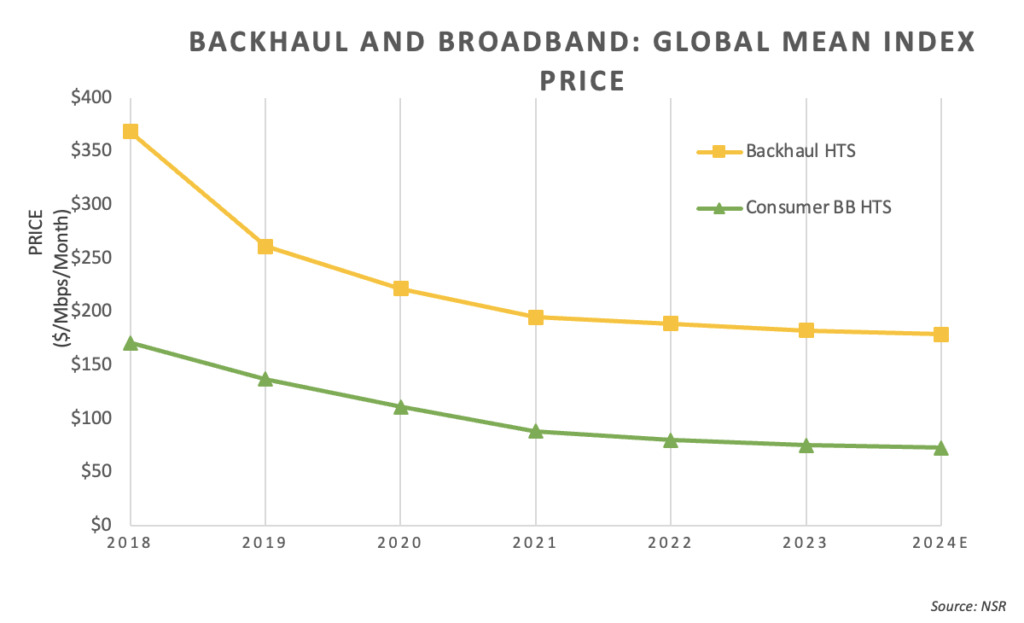The Rise of Constellations: Managing the Price Impact
The Satellite Connectivity industry is undergoing a major transformation with the emergence of Non-GEO constellation players. Starlink, OneWeb & mPower are in their advanced stages, and upcoming constellations such as Kuiper, Telesat and others are deploying or planning to deploy competitive products and services targeting existing GEO markets. Resultantly, every addition of Non-GEO offerings in a given region is leading to increased competition, thereby translating into GEO-HTS Satellite capacity pricing adjustments across target applications. According to NSR’s Satellite Capacity Pricing Index, 9th Edition report, all satellite applications witnessed / are witnessing pricing movements in 2022-2023. Aero and Gov/Mil are the two applications that remained relatively stable as the major focus markets for constellation players currently are Consumer Broadband, Backhaul and Enterprise segments.
Starlink has been at the forefront of innovation in the last decade, that has translated into building Starlink services at reduced cost per Mbps. Additionally, the SpaceX & Elon Musk brand value have made it easier for Starlink to generate brand awareness and customer acquisition. In a recent tweet, Starlink posted that it has reached 1.5+ million subscribers worldwide, i.e., adding 0.5 million subscribers in the last five months. These additions include significant churn from GEO players. In Australia, NBN satellite customers are down to 94,000 while 120,000 users signed up for Starlink. The key differentiator between the two services is higher speed & more data and lower cost per Mbps. Incumbents in North America and the EU are also witnessing churn to Starlink. While Starlink continues its primary focus on un/under connected Consumer-class broadband users, OneWeb & mPower are planning to achieve and strongly position in the Satellite Backhaul market with Telco partnerships. According to NSR’s estimations, Consumer Broadband & Satellite Backhaul are the two major opportunity markets and constellation players are efficiently aligning their business models to fill the gaps in these segments.

Capacity Pricing is one of the major attributes that determines downstream pricing with multiple players in the value chain and in turn service penetration. End users seek flexible solutions that resonate with their requirements and budget. Appropriate pricing and solutions are the keys to filling the gaps between end-user expectations and offered services. NSR, in its Satellite Capacity Pricing Index, 9th Edition report noted that capacity pricing for HTS, for both Backhaul and Consumer Broadband, has dropped >50% in the last 6 years. The pace of decline did witness significant resistance during 2022-2023, due primarily and as a result of supply constraints across regions as various programs, GEO & Non-GEO witnessed delays. NSR forecasts HTS Capacity Pricing for Satellite Backhaul to reach $179/Mbps/Month and Consumer Broadband $73/Mbps/Month next year. However, long term, significant pricing pressure resulting into GEO-HTS price erosion is expected as more constellation players enter the market and existing players expand their coverage & portfolios.
Satellite Communications has a massive opportunity in the Consumer Broadband and Satellite Backhaul markets and hence, both GEO and Non-GEO players are targeting these segments. Capacity pricing, despite declines, remains a constraint for unlocking full market potential. Non-GEO constellation players are targeting this variable by building a leaner supply chain and business model. This is impacting the Capacity and Service pricing of GEO players. NSR expects the trend to accelerate in the coming years as more solutions are added in the mix and customers gain greater bargaining power.
The Bottom Line
GEO players, witnessing pressures from competition are responding by looking into multi-orbit strategies, investing in high density satellites and consolidation. Additionally, operators are adapting their pricing models to offer flexible & affordable solutions, thereby allowing customers to choose the best suited capacity and services for their needs. Will these steps be enough to manage the onslaught coming from NGEOs? These developments are still unfolding and certainly worth watching over time. It is worth noting, however, that with a solid track record, a large installed base that can be scaled, and new technologies GEO-HTS players can leverage, the price challenge can certainly be addressed and/or managed. However, other elements in the competitive landscape in terms of the GEO-NGEO interplay need to be considered in the fast-changing market dynamic.
